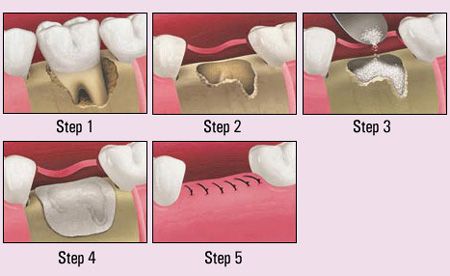Bone Grafting – Biomaterials
Confused by dental terminology?
Your dentist told you that you need an implant (or some implants) and worse still, you need a “Bone-Graft”.
The lack of bone is often the result of an extraction of a tooth. The bone surrounding the missing tooth recedes (atrophy) after an extraction. The degree of bone loss varies between individuals and localisation.
Very simplistic explanation for “Bone-grafting”: missing bone is replaced by adding bone graft, often in particle form, on or into the area which needs to be treated (with an implant). Furthermore, to prevent the fast growing gum to creep into the bone graft particles and thus hindering the process of new bone formation, the graft particles have to be covered with a “membrane”. The gum is then sutured over the membrane.
 A simplified illustration of the Bone-Grafting procedure: in this case a tooth is extracted and the socket is filled with bone graft particles. The particles are covered with a Membrane to protect the material from gum which grows at a much faster rate than bone.
A simplified illustration of the Bone-Grafting procedure: in this case a tooth is extracted and the socket is filled with bone graft particles. The particles are covered with a Membrane to protect the material from gum which grows at a much faster rate than bone.
The gum is sutured (stitched) together over the bone-graft and the membrane.
Biomaterials: what are the bone graft and the membrane made of?
Animal derived: All organic particles have been removed and only the anorganic and sterile parts of the bone is used. This is in general safe and is the most commonly used material for dental bonegraft.



What are biomaterials?
Biomaterials are non-viable materials that can be implanted to replace or repair missing tissue. They may be of natural origin or synthesised in a laboratory and are able to interact with the human body. Biomaterials, such as bone substitutes, collagen membranes and matrices, are used regularly in regenerative dentistry as well as for bone and cartilage regeneration in orthopaedics.
Non- animal derived Biomaterials?
While the use of synthetic bone graft material is possible and can deliver perfect results the problem was the cover membrane which had to be collagen (animal) as the only alternative was a NON-resorbable membrane. But that would mean a second surgical procedure to remove this membrane.
